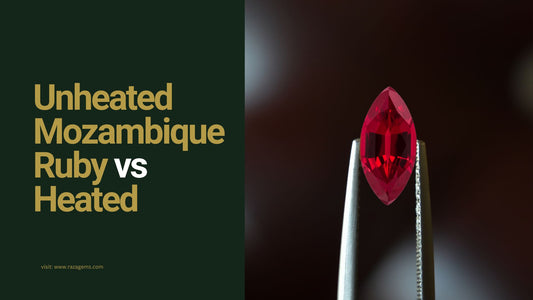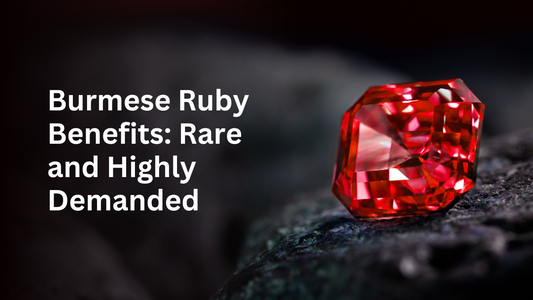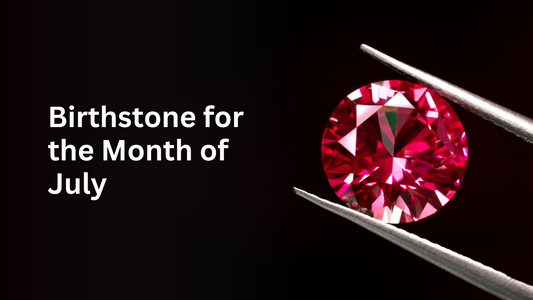
Ruby Gemstone Origin: Comparing Burmese, Thai, and African Rubies
Ruby Gemstone Origin: Comparing Burmese, Thai, and African Rubies
Introduction to Ruby Gemstone Origin
Rubies come from different parts of the world, and each place gives them special qualities:
- Burmese Ruby
- Mozambique Ruby
- Thai Ruby
- Madagascar Ruby
- Tanzanian Ruby
- Star Ruby
- Indian Ruby
These places are famous for their rubies, which vary in quality and appearance, making each gem unique. Furthermore, rubies are also sourced from Afghanistan, Vietnam, Australia, India, Russia, various regions of Africa, and the United States.
Burmese Rubies: History and Characteristics
Burmese rubies have a fascinating history tied to Burmese royalty and legends. Mining of these beautiful red gems began around 600 AD, making them highly prized for their deep "pigeon blood" red color and excellent quality. They are rare and expensive due to their consistent color and significant historical importance.
Mining and Location
Burmese rubies are usually mined from alluvial fields, limestone caves, open trenches in hillsides, and tunnels in rocks. The mining area is about 700 km north of Rangoon, the capital city. Rubies from this region are famous for their top-notch quality compared to rubies from other places.
Thai Rubies: Origins and Values
Thai rubies are among the most sought-after gemstones in the world, known for their deep red hue and high clarity. These qualities make Thai rubies highly desirable and valuable in the gemstone market.
Origins
Thai rubies primarily come from Bo Rai in Thailand's Trat province. The region has been a significant source of high-quality gem rubies for many years. It is estimated that about 70% of the world's high-quality gem rubies are sourced from Thailand, making it a key player in the ruby industry.
Values
Thai rubies are particularly notable for their very high iron (Fe) content and very low fluorescence. These characteristics contribute to their unique and appealing appearance. The deep red color, often referred to as "pigeon blood," and the high clarity of these rubies make them incredibly valuable and sought after by collectors and jewelers worldwide.
African Rubies: Mining Locations and Qualities
African rubies are highly prized for their beauty and quality, with notable mining locations in several countries across the continent. These rubies are known for their vibrant colors and high clarity, making them some of the most sought-after gemstones in the world.
Mining Locations in Africa:
-
Mozambique:
- Montepuez Mine: The largest ruby reserve in the world is found in the Montepuez mine. Gemfields owns 75% of Montepuez Ruby Mining Limitada (MRM), while Mwiriti Limitada owns the remaining 25%. Discovered in 2008 in the Niassa National Reserve, these rubies are known for their excellent clarity and fewer inclusions.
- Ruambeze: Another important location in Mozambique is known for high-quality ruby production.
-
Madagascar:
- Vatomanamena
- Didy
- Zahamena
- Ilakaka: These areas are significant sources of rubies with diverse qualities.
-
Kenya:
- Mangare
- Baringo: Kenyan rubies are known for their distinctive beauty.
-
Tanzania:
- Kalalani
- Morogoro
- Mahenge
- Loolera: Tanzanian rubies are rare and highly valued.
-
Malawi:
- Chimwadzulu: Known for producing quality rubies.
African Ruby Qualities
- Mozambique Rubies: These are highly valued for their deeper, darker red color, often referred to as a rich garnet-red tone. They have shown significant market value growth, and unheated Mozambique rubies are among the most expensive gemstones available today. The Montepuez mine is especially notable for producing rubies with excellent clarity, making them highly desirable.
- Tanzanian Rubies: Known for their rarity and prized qualities, Tanzanian rubies can compete with the finest Burmese rubies in terms of beauty and quality.
- Kenyan and Malawian Rubies: These rubies are also valued for their unique characteristics and high quality, contributing to the diversity of African rubies in the global market.
A remarkable example of the value and rarity of African rubies is the 55.22-carat gem from Mozambique, which sold at auction for a record $34.8 million, highlighting their status as "once-in-a-lifetime" jewels.
African rubies, with their rich history and superior qualities, continue to captivate gem enthusiasts and collectors worldwide.
Comparative Analysis of Burmese, Thai, and African Rubies
Color
- Burmese Rubies: Deep "pigeon blood" red, very vibrant and highly prized.
- Thai Rubies: Deep red but often darker due to high iron content.
- African Rubies: Vary in red shades; Mozambique rubies have a rich garnet-red tone.
Clarity
- Burmese Rubies: Very clear with few inclusions, making them highly valuable.
- Thai Rubies: Clear but can have more inclusions compared to Burmese rubies.
- African Rubies: Mozambique rubies are known for their excellent clarity with fewer inclusions.
Value
- Burmese Rubies: The most expensive due to their superior color, clarity, and historical significance.
- Thai Rubies: Valuable but generally less expensive than Burmese rubies.
- African Rubies: Mozambique rubies are among the most expensive, especially unheated ones. Example: A 55.22-carat Mozambique ruby sold for $34.8 million.
Mining Locations
- Burmese Rubies: Mined in alluvial fields, limestone caves, open trenches, and tunnels, mainly in the Mogok Valley.
- Thai Rubies: Primarily mined in Bo Rai, Trat province, Thailand.
- African Rubies: Mined in Kenya, Tanzania, Malawi, and Madagascar. The Montepuez mine in Mozambique has the largest ruby reserve.
Unique Features
- Burmese Rubies: Famous for their historical significance and the deep "pigeon blood" red color.
- Thai Rubies: Known for their high iron content and dark red hue.
- African Rubies: Especially Mozambique rubies, are valued for their rich color and market growth. They are of very high quality, competing with Burmese rubies.
Comparison
- Burmese Rubies: Best known for their vibrant color and high clarity.
- Thai Rubies: Deep red, slightly darker, and generally high clarity.
- African Rubies: Rich red, excellent clarity, especially from Mozambique, and high market value.
Each type of ruby offers unique qualities, making them special and valuable in their own ways.
Cultural Significance and Historical Uses
Rubies have held a special place in various cultures throughout history due to their vibrant color and perceived mystical properties. Here's how these precious gemstones have been culturally significant and historically used:
Symbol of Love and Commitment
- Love and Commitment: Rubies are often seen as symbols of love and commitment. Their deep red color is associated with passion and strong emotions, making them a popular choice for romantic jewelry, such as engagement rings and anniversary gifts.
Protection and Healing
- Misfortune and Illness: Historically, rubies were believed to protect their wearers against misfortune and illness. People thought that the gemstone could ward off evil spirits and negative energies.
- Talisman: Kings and queens wore rubies as talismans to attract good luck, wealth, mental peace, and prosperity. These gems were thought to provide protection in battles and during important decisions.
Power and Wealth
- Power and Wealth: Rubies were considered symbols of power and wealth. They were often set in crowns, scepters, and other royal regalia to signify the status and authority of monarchs and nobility.
Enhancing Personal Qualities
- Confidence and Vitality: It is believed that wearing rubies can enhance a person's confidence and vitality. The gemstone is thought to increase energy levels and promote a positive outlook.
- Leadership Qualities: Rubies are also associated with improving leadership qualities. They are said to help individuals make strong decisions, inspire others, and lead with confidence and clarity.
Throughout history, rubies have been much more than just beautiful gemstones. They have played significant roles in cultural rituals, royal adornments, and personal beliefs, making them truly timeless treasures.
Buying Guide: Tips for Choosing the Right Ruby
When purchasing a ruby, it's essential to understand the key factors that determine its quality and value. Here are some tips to help you choose the perfect ruby:
- Color is the Most Important Quality Factor
- Ideal Color: The finest ruby has a pure, vibrant red to slightly purplish-red color. This vivid hue is what makes rubies so captivating.
- Desirable Shade: The most desirable ruby color is often referred to as "blood red" or "pigeon blood." These terms describe the rich, deep red hue that is highly sought after.
- Clarity Refers to the Inclusions
- Inclusions: Clarity in rubies refers to the inclusions or internal imperfections within the gemstone. While some inclusions are common and accepted, fewer inclusions typically indicate a higher-quality ruby.
- Transparent Rubies: Burmese rubies, which are usually transparent and dark in color, are considered some of the best gemstones due to their clarity and deep red color.
- Cut is One of the Most Important Factors in Appearance
- Cut Quality: The cut of a ruby significantly impacts its overall appearance. A well-cut ruby will display its color more brilliantly and can enhance its clarity and brightness.
- Popular Shapes: While rubies can be cut into various shapes, the most popular shape is round. This shape often maximizes the gem’s color and sparkle.
- Carat Weight Allows for Precise Measurements
- Size and Weight: Carat weight measures the size of the ruby. Larger rubies are rarer and more valuable, but it’s crucial to balance size with color and clarity to ensure the best quality.
Additional Tips:
- Certification: Always ask for a certificate of authenticity from a reputable gemological laboratory. This document verifies the ruby’s quality and origin.
- Setting: Consider how the ruby will be set in jewelry. A good setting can enhance the ruby's beauty and protect it from damage.
- Origin: The origin of a ruby can affect its value. Burmese rubies are highly prized, but rubies from other regions like Mozambique and Thailand can also be of excellent quality.
By keeping these factors in mind, you can make an informed decision and choose a ruby that is not only beautiful but also a valuable investment.
Conclusion: Choosing the Best Ruby for You
When selecting a ruby, prioritize its color, clarity, cut, and carat weight based on your preferences and budget. Whether you're drawn to the vibrant hues of Burmese rubies, the clarity of Thai rubies, or the rich tones of African rubies, each gemstone offers unique qualities that make it special. Choose a ruby that speaks to you personally and fits your desired style, ensuring it becomes a cherished piece in your collection or a meaningful gift for a loved one.



